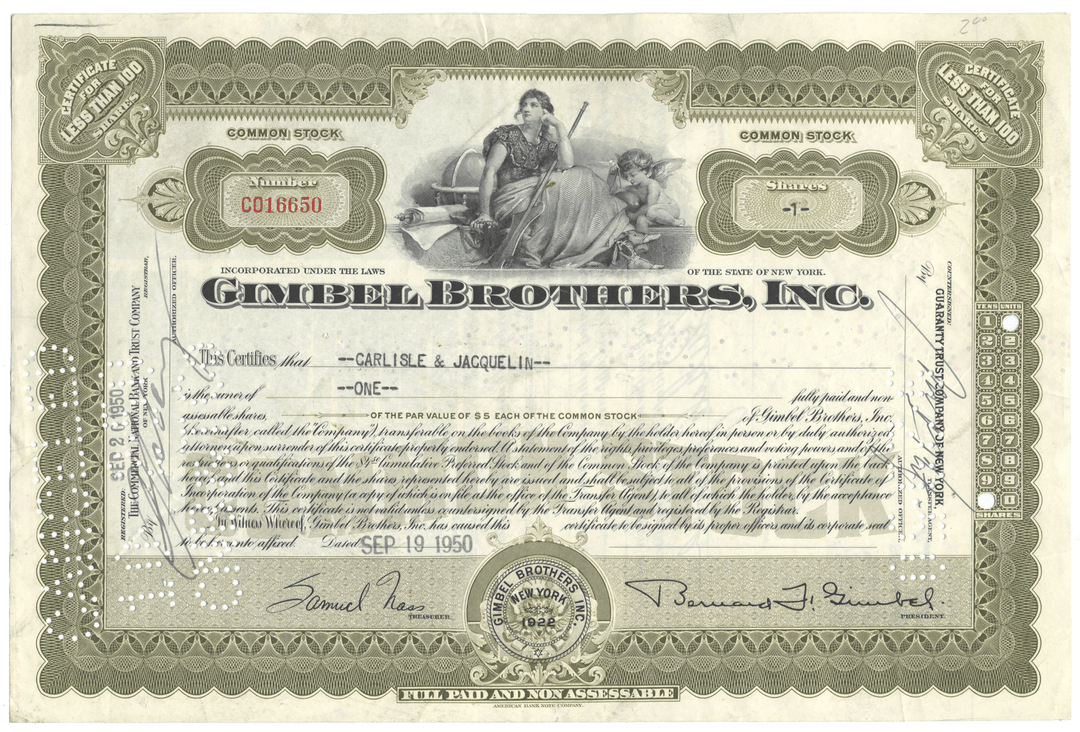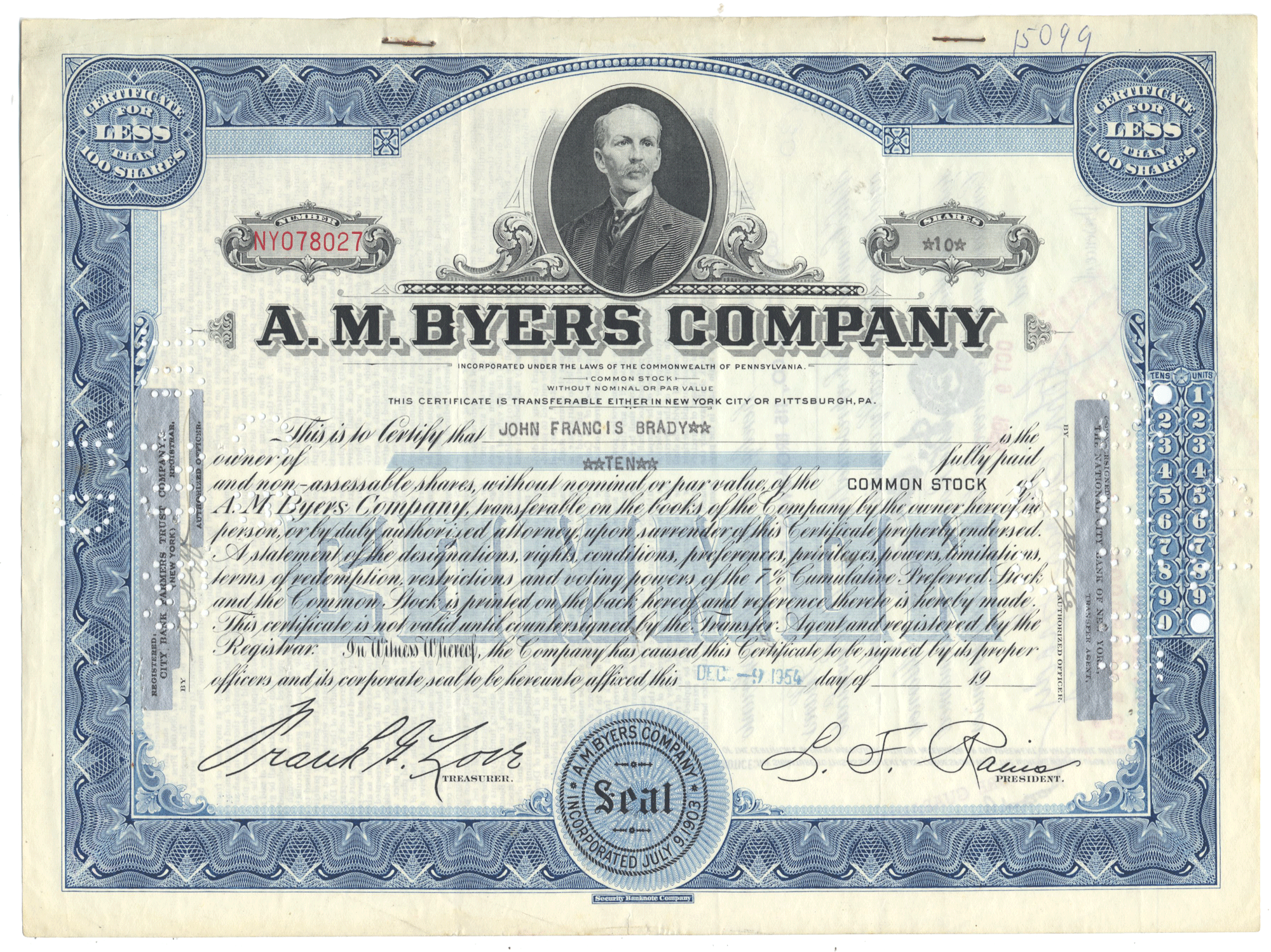
Gimbel Brothers, Inc.
- Guaranteed authentic document
- Orders over $75 ship FREE to U. S. addresses
Product Details



Gimbel Brothers, Inc.
Certificate Type
Common Stock
Date Issued
September 19, 1950
Canceled
Yes
Printer
American Bank Note Company
Signatures
Machine printed
Approximate Size
12" (w) by 8" (h)
Additional Details
NA
Historical Context

This company, founded by a young Bavarian Jewish immigrant, Adam Gimbel, began as a general store in Vincennes, Indiana. After a brief stay in Danville, Illinois, Gimbel relocated in 1887 to Milwaukee, Wisconsin, which was then a boomtown. The new store quickly became the leading department store in Milwaukee. However, with seven sons Adam Gimbel saw that one store, no matter how successful, would not accommodate his family's future.
In 1894, Gimbels - then led by the founder's son, Isaac Gimbel - acquired the Granville Haines store in Philadelphia, Pennsylvania (originally built and operated by Cooper and Conard), and in 1910, opened another branch in New York City. With its arrival in New York, Gimbels prospered, and soon became the primary rival to the leading Herald Square retailer, Macy's, whose flagship store was located a block north. This rivalry entered into the popular argot: "Would Macy's tell Gimbels?" To distinguish itself from Herald Square neighbors, Gimbels' advertising promised more: "Select, don't settle."
Gimbels became so successful that in 1922 the chain went public, offering shares on the New York Stock Exchange (though the family retained a controlling interest). The stock sales provided capital for expansion, starting with the 1923 purchase of across-the-street rival Saks & Co., which operated under the name Saks Thirty-Fourth Street. With ownership of Saks, Gimbel created an uptown branch called Saks Fifth Avenue. In 1925, Gimbels entered the Pittsburgh market with its purchase of Kaufmann & Baer's. Also acquired in this transaction was Gimbels' third radio outlet, WCAE; the company already owned WGBS in New York and WIP in Philadelphia. Although expansion spurred talk of the stores becoming a nationwide chain, the Great Depression ended that prospect. Gimbel did increase the number of more upscale (and enormously profitable) Saks Fifth Avenue stores in the 1930s, opening branches in Chicago, Boston and San Francisco.
By 1930, Gimbels had seven flagship stores throughout the country and sales of $123 million ($1.8 billion today) across 20 stores; this made Gimbel Brothers Inc. the largest department store corporation in the world. By 1953, sales had risen to $300 million ($2.8 billion today). In 1962, Gimbels acquired Milwaukee competitor Schuster's, and in that region operated stores from both chains for a while as Gimbels Schuster's. By 1965, Gimbel Brothers Inc. consisted of 53 stores throughout the country, which included 22 Gimbels, 27 Saks Fifth Avenue stores, and four Saks 34th St.
Despite its limited presence, Gimbels was well-known nationwide, in part because of the carefully cultivated rivalry with Macy's, but also thanks to an endless stream of publicity. The New York store received considerable attention as the site of the 1939-40 sale of art and antiquities from the William Randolph Hearst collection. Gimbels also gained publicity from the 1947 film Miracle on 34th Street, the 1967 film Fitzwilly, and was frequently mentioned as a shopping destination of Lucy Ricardo and Ethel Mertz on the hit 1950s TV series I Love Lucy.
The Slinky made its debut at the northeast Philadelphia Gimbels store. Also, the Philadelphia Gimbels was the first department store in the world to move customers from floor to floor via the escalator.
The idea of a department-store parade originated in 1920 with Gimbels Department Store in Philadelphia. The Gimbel family saw the parade as a way to promote holiday shopping at its various store locations. Macy's did not start a parade until 1924.
The Gimbels New York City flagship store was located in the cluster of large department stores that surrounded Herald Square, in Midtown Manhattan. Designed by architect Daniel Burnham, the structure, which once offered 27 acres of selling space, has since been modernized and entirely revamped. When this building opened in 1910, a major selling point was its many doors leading to the Herald Square New York City Subway station. Due to such easy access, by the time Gimbels closed in 1986, this store had the highest rate of "shrinkage", or shoplifting losses, in the world. Doors also opened to a pedestrian passage under 32nd Street, connecting Penn Station to the 34th Street (New York City Subway) and 33rd Street (PATH) stations. This Gimbels Passageway was closed in the 1990s for security reasons during a period of high crime.
Brown & Williamson, the American subsidiary of British-American Tobacco, a diversified conglomerate, based in Louisville, Kentucky, acquired Gimbels in 1973. Brown & Williamson also owned Marshall Field's (purchased in 1982), Frederick & Nelson, The Crescent stores, and Kohl's (purchased in 1972). Brown & Williamson later created the BATUS Retail Group as a subsidiary company for its retail holdings.
BATUS initially left the Gimbels chain in the four autonomous divisions that had been established under Gimbel family ownership: Gimbels New York, Gimbels Philadelphia, Gimbels Pittsburgh, and Gimbels Milwaukee. Each division operated independently of each other in advertising and buying. Each division offered their own credit card which could only be used at Gimbels stores in the same division. In 1983, Gimbels New York and Gimbels Philadelphia were combined into a single entity, Gimbels East, in an attempt to reduce operating losses in both divisions.
Deciding that Gimbels was a marginal performer with little potential for increased profitability, BATUS in 1986 decided to close its Gimbels division and sell its store properties. Some of the more attractive branches were taken over by Stern's (Allied Stores), Pomeroy's (Allied Stores), Kaufmann's (May Department Stores, now part of the corporate family of rival Macy's), or Boston Store (P.A. Bergner & Co.) The cornerstone of the chain, the downtown Milwaukee store where Adam Gimbel had first found success (and alleged to be the most profitable Gimbel store), was handed to BATUS sister division Marshall Field's, but eventually closed in 1997.
Related Collections
Additional Information
Certificates carry no value on any of today's financial indexes and no transfer of ownership is implied. All items offered are collectible in nature only. So, you can frame them, but you can't cash them in!
All of our pieces are original - we do not sell reproductions. If you ever find out that one of our pieces is not authentic, you may return it for a full refund of the purchase price and any associated shipping charges.





